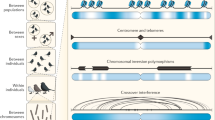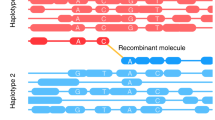Abstract
Meiotic recombination contributes to genetic diversity by yielding new combinations of alleles. Individuals vary with respect to the genome-wide recombination counts in their gametes. Exploiting data resources in Iceland, we compiled a data set consisting of 35,927 distinct parents and 71,929 parent-offspring pairs. Within this data set, we called over 2.2 million recombination events and imputed variants with sequence-level resolution from 2,261 whole genome–sequenced individuals into the parents to search for variants influencing recombination rate. We identified 13 variants in 8 regions that are associated with genome-wide recombination rate, 8 of which were previously unknown. Three of these variants associate with male recombination rate only, seven variants associate with female recombination rate only and three variants affect both. Two are low-frequency variants with large effects, one of which is estimated to increase the male and female genetic maps by 111 and 416 cM, respectively. This variant, located in an intron, would not be found by exome sequencing.
This is a preview of subscription content, access via your institution
Access options
Subscribe to this journal
Receive 12 print issues and online access
$209.00 per year
only $17.42 per issue
Buy this article
- Purchase on Springer Link
- Instant access to full article PDF
Prices may be subject to local taxes which are calculated during checkout


Similar content being viewed by others
Accession codes
References
Baudat, F. et al. PRDM9 is a major determinant of meiotic recombination hotspots in humans and mice. Science 327, 836–840 (2010).
Coop, G., Wen, X., Ober, C., Pritchard, J.K. & Przeworski, M. High-resolution mapping of crossovers reveals extensive variation in fine-scale recombination patterns among humans. Science 319, 1395–1398 (2008).
Kong, A. et al. A high-resolution recombination map of the human genome. Nat. Genet. 31, 241–247 (2002).
Broman, K.W., Murray, J.C., Sheffield, V.C., White, R.L. & Weber, J.L. Comprehensive human genetic maps: individual and sex-specific variation in recombination. Am. J. Hum. Genet. 63, 861–869 (1998).
Kong, A. et al. Sequence variants in the RNF212 gene associate with genome-wide recombination rate. Science 319, 1398–1401 (2008).
Chowdhury, R., Bois, P.R., Feingold, E., Sherman, S.L. & Cheung, V.G. Genetic analysis of variation in human meiotic recombination. PLoS Genet. 5, e1000648 (2009).
Fledel-Alon, A. et al. Variation in human recombination rates and its genetic determinants. PLoS ONE 6, e20321 (2011).
Stefansson, H. et al. A common inversion under selection in Europeans. Nat. Genet. 37, 129–137 (2005).
Hinch, A.G. et al. The landscape of recombination in African Americans. Nature 476, 170–175 (2011).
Kong, A. et al. Detection of sharing by descent, long-range phasing and haplotype imputation. Nat. Genet. 40, 1068–1075 (2008).
Kong, A. et al. Parental origin of sequence variants associated with complex diseases. Nature 462, 868–874 (2009).
Kong, A. et al. Fine-scale recombination rate differences between sexes, populations and individuals. Nature 467, 1099–1103 (2010).
Jonsson, T. et al. A mutation in APP protects against Alzheimer's disease and age-related cognitive decline. Nature 488, 96–99 (2012).
Devlin, B. & Roeder, K. Genomic control for association studies. Biometrics 55, 997–1004 (1999).
Reim, K. et al. Complexins regulate a late step in Ca2+-dependent neurotransmitter release. Cell 104, 71–81 (2001).
Sauvageau, M. & Sauvageau, G. Polycomb group proteins: multi-faceted regulators of somatic stem cells and cancer. Cell Stem Cell 7, 299–313 (2010).
Nagel, A.C., Fischer, P., Szawinski, J., Rosa, M.K. & Preiss, A. Cyclin G is involved in meiotic recombination repair in Drosophila melanogaster. J. Cell Sci. 125, 5555–5563 (2012).
Lynn, A., Soucek, R. & Borner, G.V. ZMM proteins during meiosis: crossover artists at work. Chromosome Res. 15, 591–605 (2007).
Shinohara, M., Oh, S.D., Hunter, N. & Shinohara, A. Crossover assurance and crossover interference are distinctly regulated by the ZMM proteins during yeast meiosis. Nat. Genet. 40, 299–309 (2008).
Reynolds, A. et al. RNF212 is a dosage-sensitive regulator of crossing-over during mammalian meiosis. Nat. Genet. 45, 269–278 (2013).
Rada-Iglesias, A. et al. A unique chromatin signature uncovers early developmental enhancers in humans. Nature 470, 279–283 (2011).
Ward, J.O. et al. Mutation in mouse hei10, an E3 ubiquitin ligase, disrupts meiotic crossing over. PLoS Genet. 3, e139 (2007).
Chelysheva, L. et al. The Arabidopsis HEI10 is a new ZMM protein related to Zip3. PLoS Genet. 8, e1002799 (2012).
Chowdhury, D. et al. A PP4-phosphatase complex dephosphorylates γ-H2AX generated during DNA replication. Mol. Cell 31, 33–46 (2008).
Nakada, S., Chen, G.I., Gingras, A.C. & Durocher, D. PP4 is a γH2AX phosphatase required for recovery from the DNA damage checkpoint. EMBO Rep. 9, 1019–1026 (2008).
Gutiérrez-Caballero, C. et al. Identification and molecular characterization of the mammalian α-kleisin RAD21L. Cell Cycle 10, 1477–1487 (2011).
Ishiguro, K., Kim, J., Fujiyama-Nakamura, S., Kato, S. & Watanabe, Y. A new meiosis-specific cohesin complex implicated in the cohesin code for homologous pairing. EMBO Rep. 12, 267–275 (2011).
Lee, J. & Hirano, T. RAD21L, a novel cohesin subunit implicated in linking homologous chromosomes in mammalian meiosis. J. Cell Biol. 192, 263–276 (2011).
Llano, E. et al. Meiotic cohesin complexes are essential for the formation of the axial element in mice. J. Cell Biol. 197, 877–885 (2012).
Herrán, Y. et al. The cohesin subunit RAD21L functions in meiotic synapsis and exhibits sexual dimorphism in fertility. EMBO J. 30, 3091–3105 (2011).
Sandor, C. et al. Genetic variants in REC8, RNF212, and PRDM9 influence male recombination in cattle. PLoS Genet. 8, e1002854 (2012).
Novak, J.E., Ross-Macdonald, P.B. & Roeder, G.S. The budding yeast Msh4 protein functions in chromosome synapsis and the regulation of crossover distribution. Genetics 158, 1013–1025 (2001).
Ross-Macdonald, P. & Roeder, G.S. Mutation of a meiosis-specific MutS homolog decreases crossing over but not mismatch correction. Cell 79, 1069–1080 (1994).
Kneitz, B. et al. MutS homolog 4 localization to meiotic chromosomes is required for chromosome pairing during meiosis in male and female mice. Genes Dev. 14, 1085–1097 (2000).
Boettger, L.M., Handsaker, R.E., Zody, M.C. & McCarroll, S.A. Structural haplotypes and recent evolution of the human 17q21.31 region. Nat. Genet. 44, 881–885 (2012).
Steinberg, K.M. et al. Structural diversity and African origin of the 17q21.31 inversion polymorphism. Nat. Genet. 44, 872–880 (2012).
Suzuki, T. et al. Expression of a testis-specific form of Gal3st1 (CST), a gene essential for spermatogenesis, is regulated by the CTCF paralogous gene BORIS. Mol. Cell. Biol. 30, 2473–2484 (2010).
Sleutels, F. et al. The male germ cell gene regulator CTCFL is functionally different from CTCF and binds CTCF-like consensus sites in a nucleosome composition-dependent manner. Epigenetics Chromatin 5, 8 (2012).
Cole, F. et al. Homeostatic control of recombination is implemented progressively in mouse meiosis. Nat. Cell Biol. 14, 424–430 (2012).
Lenzi, M.L. et al. Extreme heterogeneity in the molecular events leading to the establishment of chiasmata during meiosis I in human oocytes. Am. J. Hum. Genet. 76, 112–127 (2005).
Marchini, J., Howie, B., Myers, S., McVean, G. & Donnelly, P. A new multipoint method for genome-wide association studies by imputation of genotypes. Nat. Genet. 39, 906–913 (2007).
Acknowledgements
We thank the three referees for comments that led to an improved version of the manuscript.
Author information
Authors and Affiliations
Contributions
A.K. and K.S. planned and directed the research. A.K. and G.T. wrote the first draft of the paper and, with K.S., M.L.F. and U.T., wrote most of the final version. Phasing was performed by D.F.G. and M.L.F., assisted by software from R.V., which called the recombination events. D.F.G. and G.M. processed the whole-genome sequencing data and performed imputation. G.T. performed the initial association analyses and also carried out the literature search for associated genes. A.K. performed most of the final analyses and calculations, including the study of chromosome-specific effects and the decomposition of variance. S.B.O. assisted in the imputation of the PRDM9 zinc-finger polymorphism, and E.M. carried out the investigation involving Encyclopedia of DNA Elements (ENCODE) data.
Corresponding authors
Ethics declarations
Competing interests
A.K., G.T., M.L.F., G.M., D.F.G., R.V., S.B.O., U.T. and K.S. are employees of deCODE Genetics/Amgen, Inc.
Supplementary information
Supplementary Text and Figures
Supplementary Note, Supplementary Tables 1–9 and Supplementary Figures 1 and 2 (PDF 3362 kb)
Supplementary dataset
Supplementary Data Set (ZIP 7803 kb)
Rights and permissions
About this article
Cite this article
Kong, A., Thorleifsson, G., Frigge, M. et al. Common and low-frequency variants associated with genome-wide recombination rate. Nat Genet 46, 11–16 (2014). https://doi.org/10.1038/ng.2833
Received:
Accepted:
Published:
Issue Date:
DOI: https://doi.org/10.1038/ng.2833
This article is cited by
-
The RING Domain of Rice HEI10 is Essential for Male, But Not Female Fertility
Rice (2024)
-
Variant in the synaptonemal complex protein SYCE2 associates with pregnancy loss through effect on recombination
Nature Structural & Molecular Biology (2024)
-
High male specific contribution of the X-chromosome to individual global recombination rate in dairy cattle
BMC Genomics (2022)
-
Recombination rates in pigs differ between breeds, sexes and individuals, and are associated with the RNF212, SYCP2, PRDM7, MEI1 and MSH4 loci
Genetics Selection Evolution (2022)
-
In silico analysis of a novel pathogenic variant c.7G > A in C14orf39 gene identified by WES in a Pakistani family with azoospermia
Molecular Genetics and Genomics (2022)



